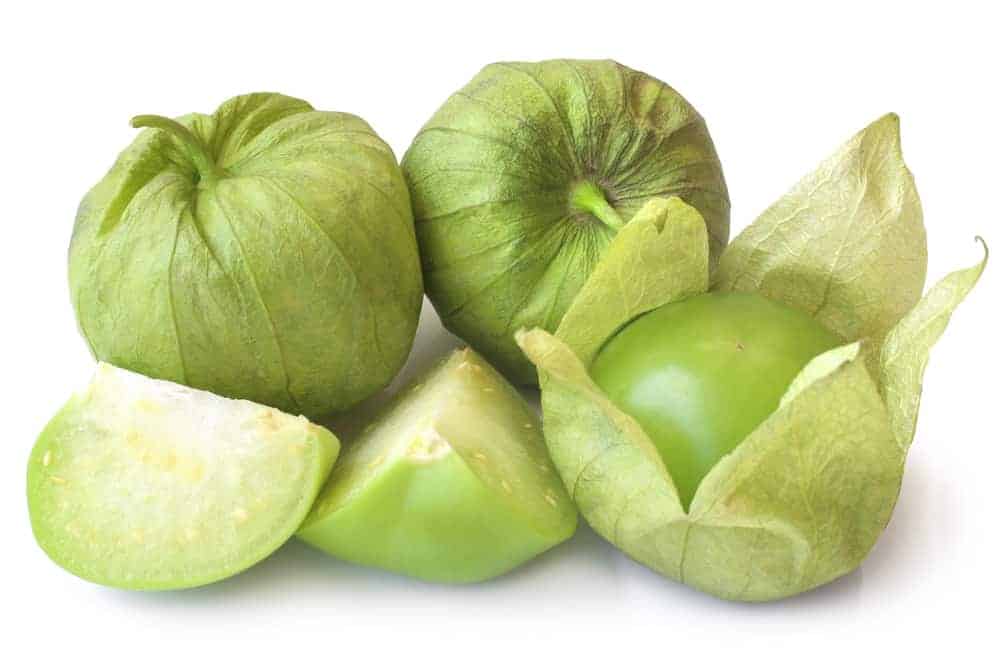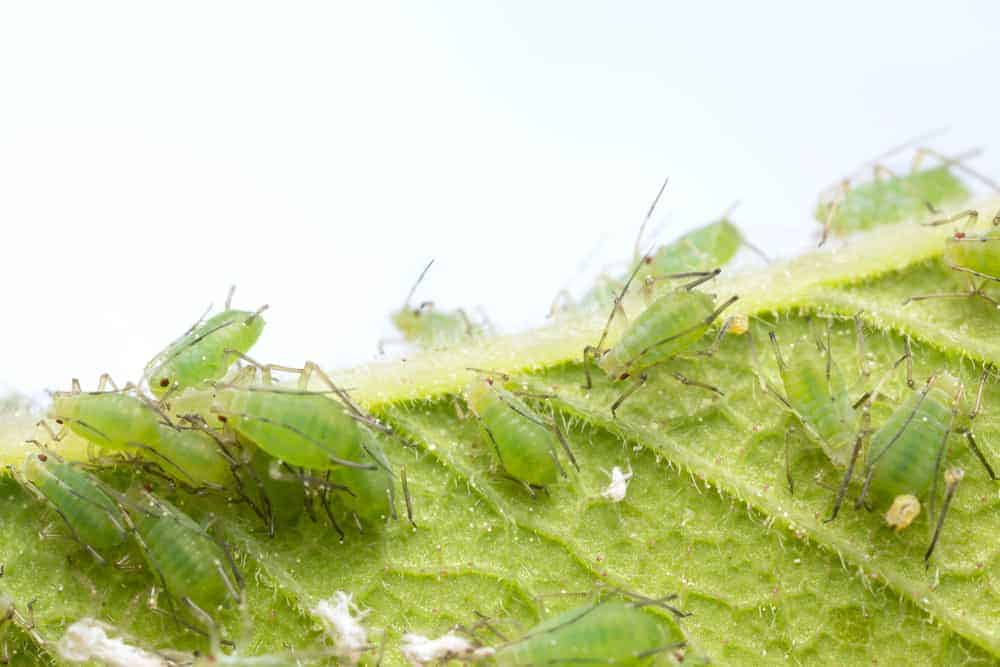The tomatillo (husk tomato, tomate verde, ground cherry, jamberry) looks like a green tomato enclosed in the calyx (wrapping). Green, yellow, orange, purple, or red round fruits are approximately 1 to 2 inches (2.5 – 5 cm) large and have a sharp, tart, citrus-like taste.
Since tomatillos produce fruits throughout the growing season without a break, they are concerned indeterminate plants. They are quite easy to grow, but just a few gardeners outside the Southwest decide to plant this vegetable.
Why You Should Grow Tomatillo

Tomatillo (Physalis philadelphica) originates from Central America, and it is believed that Aztecs domesticated this plant almost 3000 years ago. Nowadays, gardeners all around the world grow this plant, but it is still mostly associated with salsa and Mexico.
Even today, in the mid-western US, people consider wild varieties of this veggie as weeds. However, native tribes in North America use them as a cure for headache and stomachache.
Regarding the nutrients, this warm season veggie low in calories contains a lot of vitamin C, vitamin A, vitamin K, niacin (vitamin B3), iron, potassium, selenium, and fiber.
How to Plant Tomatillos in Your Garden

If you live in the northern States, the best solution is sowing seeds indoors first. Otherwise, you can sow them directly in your garden as soon as a danger of frost passes. In average, you will need 2.25 ounces (64 g) of seed per acre.
Place seeds in the ground about 0.25 inches (0.6 cm) deep, approximately six to eight weeks before the last spring frost. If you provide optimal conditions to your vegetable, you can count on 75% of the seeds to germinate.
Seedlings are prepared for transplanting in your garden about a month after sowing. Use your own seedlings or purchase 3-week old ones at a greenhouse. Take care to plant them in groups since tomatillos are not self-pollinating veggies. In general, two to four plants are enough for the average household.
As a third solution, you can use cuttings. Since they root very quickly and effortlessly, you can plant your vegetable that way, especially if you can’t find seedlings in the region you live in.
How to Care Tomatillos in Your Garden
Space

In the US, gardeners grow tomatillos as an annual crop on a vine. The size of the mature tomatillo plant can vary depending on growing conditions and the plant’s variety, but most of them are approximately 1.5 to 3 feet (46 – 91.5 cm) tall and 18 to 24 inches (46 – 61 cm) wide.
Therefore, they need a lot of space and excellent support to thrive lush and healthy. Since the most varieties grow as a bush, you should space them at least 24 to 48 inches (61 – 122 cm) apart and provide 4 to 5 feet (1.2 – 1.5 m) between the rows.
Soil
Tomatillos grow best when the soil is well-drained, nutrient-rich, and sandy, with the pH from 6.5 to 7.0. Avoid soaking ground too much since those veggies are native to a warm climate.
Mulching

The best way to prevent weeds growing and keep the soil moist is to add 2 to 3 inches (5 – 7.6 cm) thick layer of organic mulch, preferably straw, dry clippings, and leaves around your plants.
Temperatures
Tomatillos are highly sensitive to low temperatures. You shouldn’t sow or transplant this vegetable in the garden until the soil is not warm enough, without danger of frost. Wait while the temperatures reach at least 50 F (10 C) and the nights become warmer.
In general, the ideal temperatures for growing tomatillos are from 70 to 90 F (21 – 32 C), but higher ones won’t bother your plants as well.
However, if the average temperatures in the region you live in are higher than 100 F (37.8), you should consider some afternoon shade for your vegetable.
Watering

Since these veggies like having an abundance of water, you should provide approximately 1 to 1.5 inches (2.5 – 3.8 cm) of water per week for them. However, be careful because they won’t thrive when the soil is too soggy.
Therefore, let the ground dry between two watering. That way, your plants will grow healthy and lush, their root systems will be strong, and fruits will ripe more quickly. Help your soil keep moist by adding some organic mulch.
One more thing! Never sprinkle your plants overhead since wet foliage will be prone to various diseases.
Fertilizing
Tomatillos don’t require too much fertilizer, but you may test your soil to check the level of existing nutrients. In general, it is enough to apply potassium and phosphorus if needed.
However, try to avoid adding a higher amount of nitrogen because you don’t need bushy and leafy plants without fruits. Adding compost, well-rotted manure, or well-balanced 10-10-10 fertilizer in spring or autumn will provide enough nutrients to this crop.
Apply 1 to 2 pounds (0.45 – 0.9 kg) of fertilizer per 100 sq ft (9 m2) and place it 4 to 6 inches (10 – 15 cm) deep into the soil. You can also dose compost tea occasionally to add beneficial microbes to the ground.
Weeding

You should weed your vegetable regularly to improve air circulation among the foliage. That is the best prevention of leaf diseases. Dig the ground around your plants with a garden hoe, and prevent the growth of weeds. Just take care to avoid damaging the plant’s roots.
Pruning
Light pruning is an excellent solution for your tomatillos since it will provide better air circulation around these veggies. That means that you need to remove most of the sucker shoots which have been created between the main stem and branches.
Once they become 2 to 4 inches (5 – 10 cm) long, pinch them off or use pruning shears to trim them off. Be careful! Don’t remove all of the sucker shoots. The goal is providing better air circulation not to reduce your yields.
Also, try to force growing the plants with just one main stem because it will promote faster ripening of the fruits. On the other hand, two stems growing from the same base will increase the amount of produced fruit. Which one approach you will have depends on your preferences.
How to Harvest Tomatillos

In the very beginning, your tomatillo plants will thrive in height and produce abundant foliage. You can expect the first fruits in approximately 60 to 100 days after transplanting. As the fruits start filling out, you will see that the plant’s husks split open. Cut fruits from the plant without pulling them to avoid damaging the stems.
You can collect your vegetable right away. Peel away the husk and wash a sticky film from fruits before consumption. However, if you want to store them, let the husks stay on fruits and put them in the fridge for a few weeks.
| Green tomatillo | Purple tomatillo | Yellow tomatillo | |||
| Variety | Harvesting time | Variety | Harvesting time | Variety | Harvesting time |
| Gigante | 100 days | De Milpa | 70 days | Pineapple | 75 days |
| Rio Grande | 85 days | Purple Coban | 70 days | Mexican Strain | 65 days |
| Miltomate | 80 days | Tiny From Coban | 70 days | Amarylla | 60 days |
| Tamayo | 65 days | ||||
| Toma Verde | 60 days | ||||
If you are patient enough, you can wait for a while because the mature fruits are much sweeter. Pull up your tomatillos before the first frost jeopardizes them, hang them upside down in a cold place, and use fruits during a few winter months.
The more tomatillos you pick, the more of them will ripe. As a result, your plants will keep producing continuously. In general, you can expect 60 to 200 fruits per one plant in a growing season, which is approximately 2.5 pounds (1.1 kg).
Don’t miss to collect all the fruits to avoid dropping seeds around and uncontrolled popping up of new plants the following spring.
How to Store Tomatillos

There are a few ways for tomatillo storage. Left in the husk, your tomatillos will last a week or two. If you wash and dry fruits and remove all the husks, you can freeze them successfully. Use truly ripe fruits and make jam.
You can also store your tomatillos up to a month in a cool, well-aerated place as long as the temperature is from 50 to 60 F (10 – 15.5 C) and humidity about 60%.
Tomatillos Pests and Diseases
Tobacco mosaic virus

The first sign of this infection is dark-green mottlings of foliage and stunting of young plants. The virus won’t affect fruits, but you can expect them to become smaller.
Destroy all plants and avoid smoking while working in the garden since you can transfer the causative agent by your hands.
Bacterial leaf spot

When you notice tiny spots surrounded by a yellowish edge, and with a reddish center on your plants’ foliage and flower heads, you will know that it is about this bacterial infection.
You can expect this disease occurs while the temperatures are low. Fight it by regular crop rotating and removing affected plants.
Wilt disease

Since bacteria live in the ground and enter your vegetable through the roots, this infection leads to rapid wilting of your plants which die eventually.
Fusarium wilt

It is a highly damaging fungus disease which spreads among your veggies during hot periods. The fungi enter through the plant’s roots and destroy the stems with a toxin.
Once wilts occur, you should avoid planting tomatillos in that area for at least four seasons. Also, try to rotate crops regularly.
Anthracnose

This disease caused by fungi affects tomatillo fruits while ripening. At the very beginning, a circular, slightly sunken spots occur on the fruits’ skin and become more significant and black over time. The result is rotting of fruits.
The main reason for the appearance of this infection is a more extended period of higher humidity during summer. You can avoid it by providing excellent air circulation between plants and moderate watering. Once the fungus spores get to the ground, you need to destroy all existing plants.
Spider mites

Those tiny creatures suck on the juices of your tomatillo and cause white dots on their leaves. As a result, the foliage will become yellow and dry. Control these spider-like pests with an insecticide soap, insecticide spray, or hot pepper wax.
Aphids

While those sucking insects feed on foliage, they may spread diseases. Plus, they always attract ants by a sticky residue they leave under the leaves. Get rid of them by attracting wasps and lady beetles as natural predators into your garden. They will feed on these creatures and keep your tomatillos safe.
Root knot nematodes

Those microscopic worms affect roots, and they will become swollen. Consequently, your tomatillos will probably wilt and become stunted. You can’t do anything for your plants except to avoid planting them on the infested ground.
Cutworms

These insects will cut off the stems of your new seedlings and cause their death. Solve the problem by hand-picking their eggs or placing a paper cup collar around the base of tomatillos’ stems.
Slugs
These feed on leaves of your tomatillos and leave large holes in them. In the end, your plants will stay without any foliage. You can try to hand pick slugs during the night or to use beer or cornmeal traps to catch them.

Leave a comment